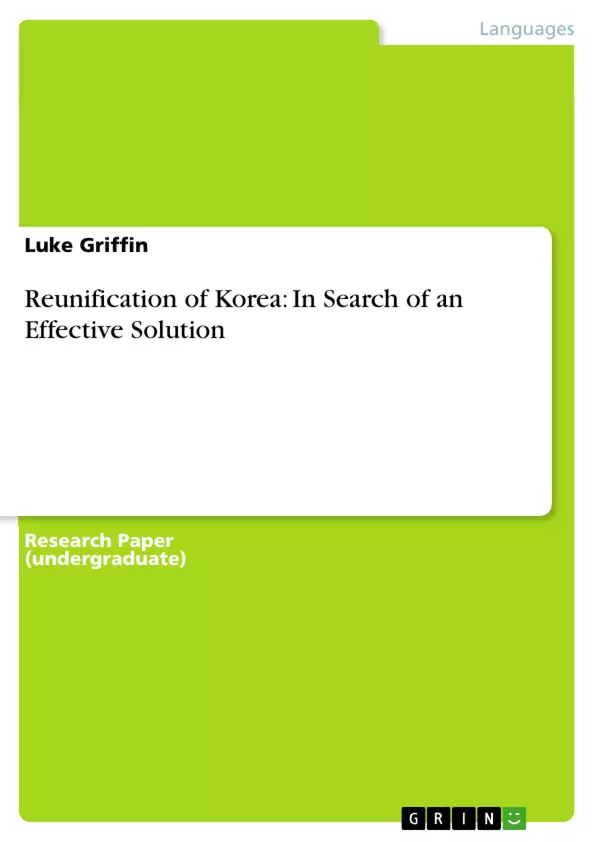This research paper provides a critical analysis of past and present methods adopted by China, the United States, as well as North and South Korea for the purpose of Korean reunification. It establishes a historical and cultural context with which these different policy approaches have evolved and notes the various utilities and insufficiencies of each. Common diplomatic obstacles that have previously thwarted attempts at improving conditions within North Korea will also be highlighted, as these challenges are likely to have a continued effect on the future prospects of reunification. This paper also examines the vastly negative economic and sociological implications of reunifying the two Koreas, as this has resulted in a strong political incentive to maintain the status quo. A body of research will be drawn upon to establish the most economically viable method for reunification to address these issues. Finally, the purpose of this paper is to incorporate all of the topics examined to propose a pragmatic and viable solution to the issues that stand in the way of a reunified Korea.
Inhaltsverzeichnis (Table of Contents)
- The War, the Dictator, and His Son
- Diplomatic Brick Walls and the Way Through
Zielsetzung und Themenschwerpunkte (Objectives and Key Themes)
This research paper examines the history and feasibility of Korean reunification, analyzing past and present approaches by China, the United States, and North and South Korea. The paper highlights the diplomatic and economic challenges that have historically hindered reunification efforts and the political incentives to maintain the status quo. It then draws upon research to propose a pragmatic and viable solution to the issues surrounding Korean reunification.
- Historical context of the division of Korea and the evolution of different reunification policies
- Obstacles to reunification, including diplomatic barriers and the economic implications
- The role of the Juche system in North Korea's isolation and its incompatibility with other regional interests
- The political and economic challenges of reunification, specifically the vast disparities between North and South Korea
- A proposed pragmatic and viable solution for Korean reunification
Zusammenfassung der Kapitel (Chapter Summaries)
- The War, the Dictator, and His Son: This chapter delves into the historical background of the Korean War and the rise of Kim Il-Sung to power in North Korea. It examines the role of the Soviet Union in establishing a puppet regime and the conflict between different factions within the communist movement. The chapter also discusses Kim Il-Sung's attempt to conquer South Korea, the resulting armistice agreement, and the consolidation of his authoritarian rule. It further highlights the detrimental effects of Kim Jong-Il's regime on North Korea's economic and social conditions, emphasizing the military-first policy and its implications.
- Diplomatic Brick Walls and the Way Through: This chapter analyzes the reunification policies of North and South Korea, the United States, and China. It explores the conflicting perspectives and terms of reunification proposed by each country, highlighting the major obstacle posed by North Korea's adherence to the Juche system. The chapter also examines the South Korean government's hesitation towards reunification and the significant opposition within South Korean society.
Schlüsselwörter (Keywords)
This research paper focuses on the complex issue of Korean reunification, examining historical context, diplomatic obstacles, economic challenges, and potential solutions. Key themes include the Korean War, the Juche system, North and South Korea's differing reunification policies, the impact of external actors like China and the United States, and the feasibility of a unified Korea. The paper draws upon research in international relations, political science, and economics to provide a comprehensive analysis of this long-standing issue.
- Arbeit zitieren
- Luke Griffin (Autor:in), 2011, Reunification of Korea: In Search of an Effective Solution, München, GRIN Verlag, https://www.hausarbeiten.de/document/184523


